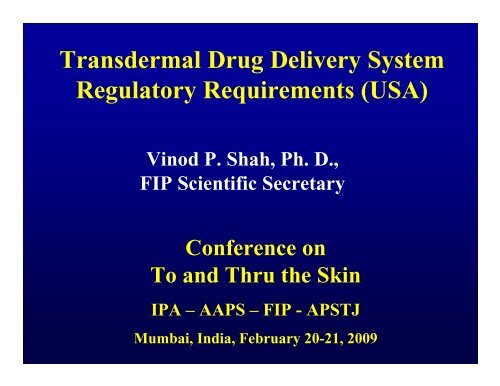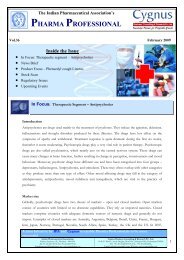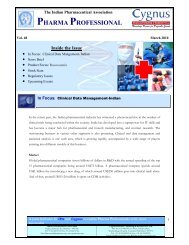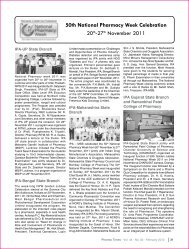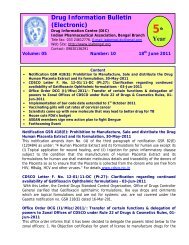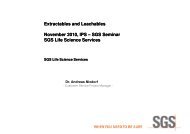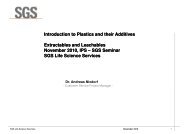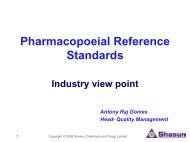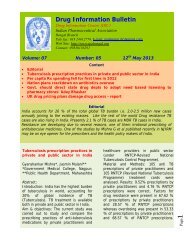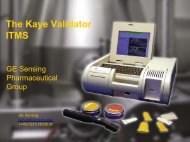Transdermal Drug Delivery System Regulatory Requirements (USA)
Transdermal Drug Delivery System Regulatory Requirements (USA)
Transdermal Drug Delivery System Regulatory Requirements (USA)
You also want an ePaper? Increase the reach of your titles
YUMPU automatically turns print PDFs into web optimized ePapers that Google loves.
<strong>Transdermal</strong> <strong>Drug</strong> <strong>Delivery</strong> <strong>System</strong><br />
<strong>Regulatory</strong> <strong>Requirements</strong> (<strong>USA</strong>)<br />
Vinod P. Shah, Ph. D.,<br />
FIP Scientific Secretary<br />
Conference on<br />
To and Thru the Skin<br />
IPA – AAPS – FIP - APSTJ<br />
Mumbai, India, February 20-21, 2009
<strong>Regulatory</strong> Authority<br />
Mission<br />
“Assure that<br />
SAFE and EFFECTIVE<br />
drugs are marketed in the<br />
country and are available<br />
to the People”
<strong>Transdermal</strong> <strong>Drug</strong> <strong>Delivery</strong> <strong>System</strong>s<br />
Advantages<br />
• Avoid first pass metabolism<br />
• Avoid GI side effects/disorders/degradation<br />
• Can be easily removed from the body<br />
Limitations<br />
• Low molecular weight (500 daltons)<br />
• Lipophilic in nature<br />
• Low dose
<strong>Transdermal</strong> <strong>Drug</strong> <strong>Delivery</strong> <strong>System</strong><br />
There is no epidemiologic data<br />
available to determine whether<br />
Safety & Efficacy<br />
with transdermal route of<br />
administration will be different<br />
than the oral route.
<strong>Transdermal</strong> <strong>Drug</strong> <strong>Delivery</strong> <strong>System</strong><br />
In Vitro Product Quality Tests<br />
• Compendial /Application tests<br />
• Identification, assay, content uniformity, …<br />
• Adhesive test<br />
• Leak test<br />
• Stability test<br />
In Vitro Product Performance Tests<br />
• In vitro release test
Advances in TDD <strong>System</strong>s<br />
• Active Poration<br />
• Thermal ablation<br />
• Electrical ablation – Iontophoresis<br />
• Ultrasound<br />
• Radio frequency ablation<br />
• Mechanical ablation – Micro needles
Advances in TDD <strong>System</strong>s<br />
• New Polymeric Technologies<br />
Can stick to dry or wet surfaces<br />
• Micro channels for delivery of<br />
water soluble drugs and macro molecules<br />
• Matrix controlled membrane systems<br />
• Passport <strong>System</strong><br />
Patch attached to a film of metallic filaments (Porator) <br />
creates aqueous channels 30-50 micrometers for drug delivery
<strong>Transdermal</strong> <strong>Drug</strong> <strong>Delivery</strong> <strong>System</strong>s<br />
Active transdermal technology<br />
• Mechanical Microporation – micro needles<br />
– To deliver small and large molecules through<br />
the skin (1 micron size), proteins and vaccines,<br />
high-dose hydrophilic drugs<br />
• Creates temporary micropores - disruption<br />
of stratum corneum to create a passage
<strong>Transdermal</strong> <strong>Drug</strong> <strong>Delivery</strong> <strong>System</strong>s<br />
Iontophoresis<br />
Active transdermal technology<br />
• For water soluble, ionized drugs<br />
• Hybresis – <strong>Transdermal</strong> iontophoretic drug<br />
delivery system R (IOMED). It consists of<br />
miniaturized, wireless dose controller that<br />
connects directly to the integrated drug<br />
delivery system.
<strong>Transdermal</strong> <strong>Drug</strong> <strong>Delivery</strong> <strong>System</strong>s<br />
• DOT Matrix<br />
• Two polymers in its drug in adhesive blend<br />
– an acrylic that holds high concentration of<br />
drug in microcells and a silicone that holds<br />
the patch to the skin.<br />
• Drives more drug through a smaller area<br />
• Advantage – smaller, more wearable<br />
patches e.g., estrogen patch
TransDermaSal<br />
• TransDermaSal Technology makes it<br />
possible to contain drugs in salt form in a<br />
nonaqueous transdermal patch formulation.<br />
– Fentanyl citrate<br />
– Oxybutynin HCl<br />
–DichlofenacNa
DermaLight<br />
• Adhesive / Polymer Technology<br />
– Pressure-sensitive adhesive technology<br />
– Increased adherence to the skin<br />
– Easy patch removal - Reduced skin irritation
<strong>Transdermal</strong> <strong>Drug</strong> <strong>Delivery</strong> <strong>System</strong><br />
• <strong>Drug</strong><br />
• Enhancer<br />
• Adhesive<br />
• Crystal inhibitor<br />
• <strong>Drug</strong> delivery<br />
Rate vs Duration<br />
Efficiency<br />
• Wear, Adhesion<br />
Irritation, Ooze<br />
Delamination<br />
• Chemically stable<br />
Should not change
<strong>Transdermal</strong> <strong>Drug</strong> <strong>Delivery</strong> <strong>System</strong><br />
Parameters<br />
• <strong>Drug</strong><br />
• Penetration Enhancers<br />
• Adhesive<br />
• Crystal inhibitor<br />
• Membrane<br />
• Preservative<br />
• Baking<br />
• Release liner<br />
• Size<br />
Performance<br />
• <strong>Drug</strong> delivery<br />
• Wear<br />
• Chemical stability<br />
• Physical stability<br />
• Economics
TDDS - Optimization<br />
• Optimum value for variables is controlled by multiple<br />
constraints<br />
• Relationship between variables and performance attributes are<br />
often nonlinear<br />
• Prototype performance must be tested after each carefully<br />
considered modification<br />
• The art of product development is maintaining the desirable<br />
product attributes<br />
• It requires fundamental understanding of many fields –<br />
chemistry, rheology, life science and problem solving skills, an<br />
inquisitive nature, patience and perseverance<br />
Focus Focus Focus
Challenges<br />
• <strong>Regulatory</strong> requirements are complex –<br />
drug + drug delivery device<br />
• Improve drug delivery and dosing rate<br />
• Develop technology / enhancers to deliver<br />
large molecules, in larger quantity<br />
• TDDS must be affordable!!!
Conclusions
Conclusions<br />
• <strong>Regulatory</strong> requirements are complex<br />
• Active and passive TDDS technologies<br />
have made strides<br />
• Quality control and drug release<br />
specifications are dependent upon the drug<br />
delivery system.
Thank You


